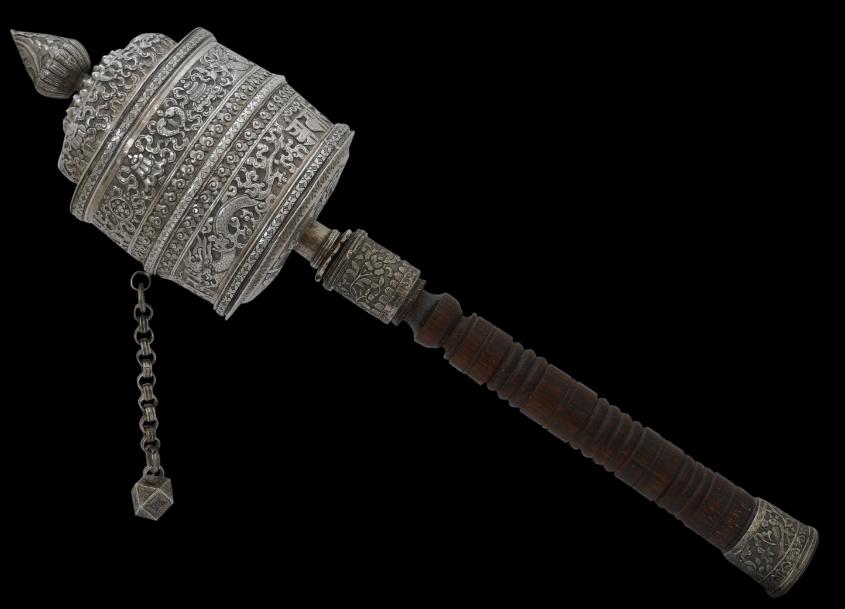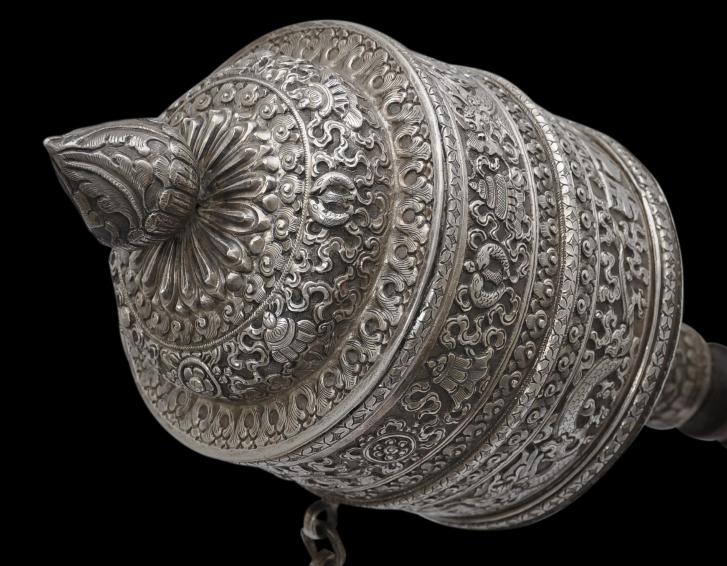
Tibetan Silver Prayer Wheel
Fine Silver Prayer Wheel (‘Khor)
Tibet
19th century
total length: 48cm, length of silver head: 16.2cm diameter of silver head: 11cm
This large Tibetan prayer wheel comprises a large ‘wheel’ with a repoussed high-grade silver top, sides and underside, a heavy silver weight shaped as an octagonal hedron, attached to the wheel by means of a silver chain, and a long wooden handle with chased silver mounts.
The domed top cover of the wheel has a large lotus-bud finial. It is chased with floral scrolls and Buddhistic motifs. The sides are similarly chased with an upper and lower register. The lower register includes several syllables in Lantsa script. The underside of the head is beautifully chased and engraved with a double vajra motif.
The silver bands on the handle are chased with Chinese-influenced flowers, foliage and birds.
The interior of the head contains the original parchment on which Tibetan Buddhist mantras are likely to be printed. The parchment clearly is long and tightly wound round and enclosed in a (now faded) orange cloth cover that has been sewn shut so that only glimpses of the parchment inside are possible.
Tibetans use mantras in many ways. They are used to invoke energies for ritual or magical purposes. Om mani padme hum is the best known example of a Tibetan mantra but there are many others. Mantras only work if learned and uttered ‘properly’ (Rawson, 1991, p. 78.) Reciting mantras can even affect one’s karma. The more often mantras can be recited, the greater their benefit. Mantras might be written on flags so that the mantra is deemed to have been ‘said’ as the wind blows through or past it. Another way to be deemed to have recited a mantra without actually having said it, is to turn a prayer wheel which either has the mantra emblazoned on its outside or written on parchment on the inside, so that each turn of the wheel is equivalent to one recital of the mantra. Consequently, many Tibetans endlessly turned prayer wheels.
This example is unusually large and is not for regular of everyday use. Most probably it was commissioned for use in a noble household or perhaps was commissioned by a wealthy Tibetan for donation to a monastery as an act of merit. It is in excellent condition and appears to have been barely used. The wooden handle shows age as does the fabric in which the mantra parchment is enclosed. The prayer wheel was sourced from the south of England. It is likely that it was acquired in Tibet or India when it was relatively new perhaps in the nineteenth century and has been well stored in the UK since.
References
Beer, R., The Encyclopedia of Tibetan Symbols and Motifs, Serindia, 2004.
Rawson, P., Sacred Tibet, Thames & Hudson, 1991.
Provenance:
UK antiques market
Inventory no.: 3368
SOLD



